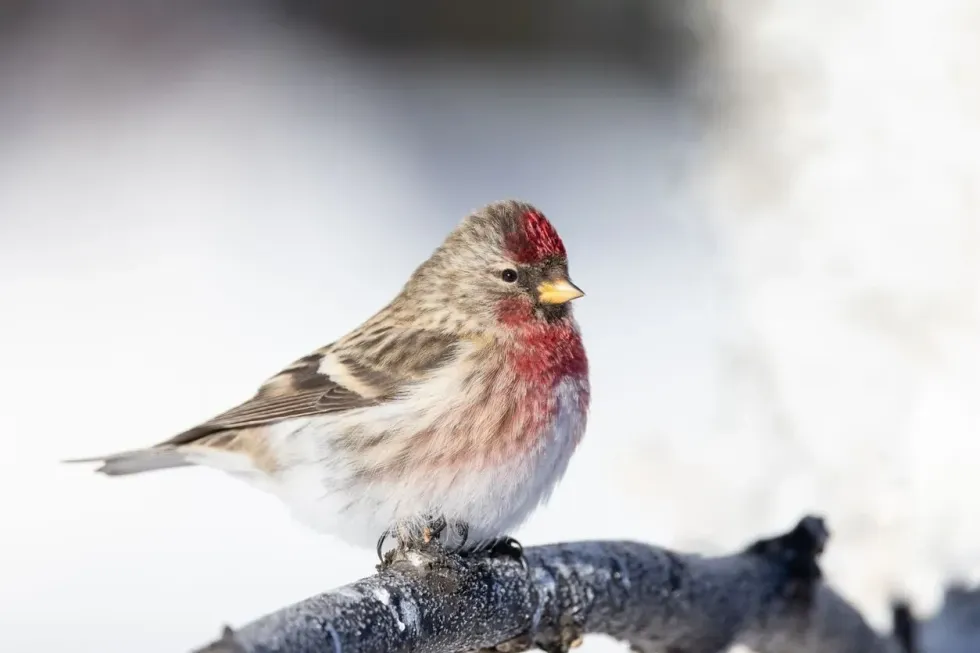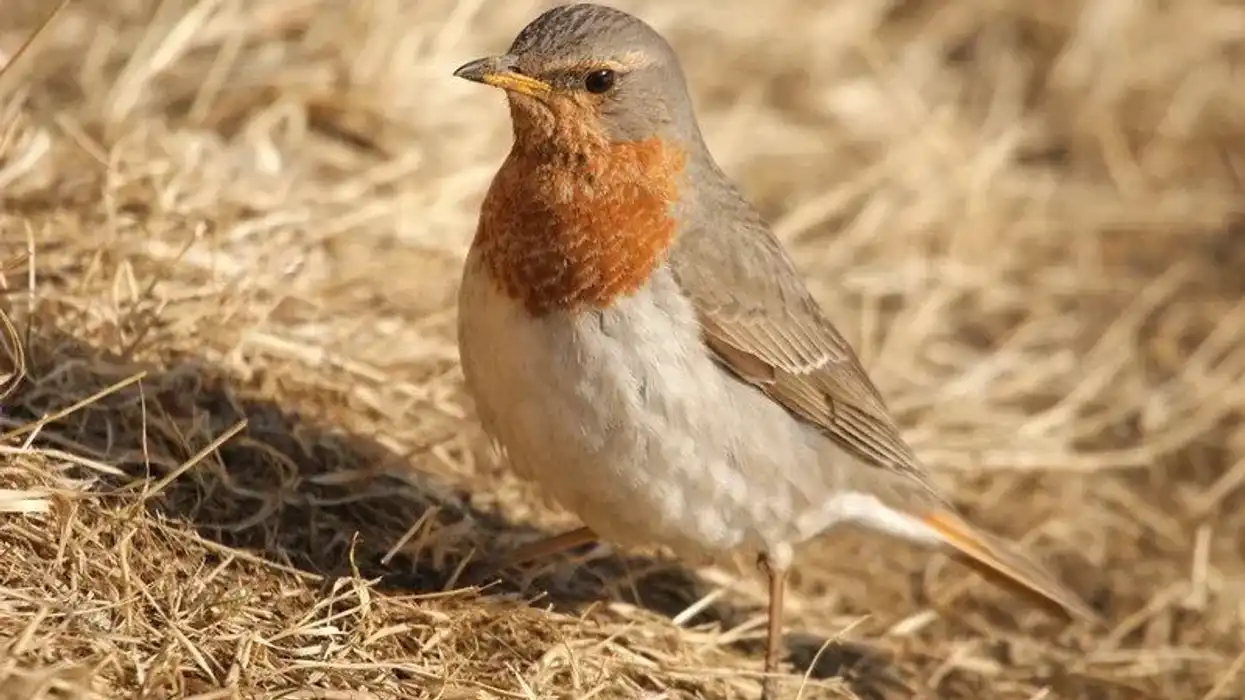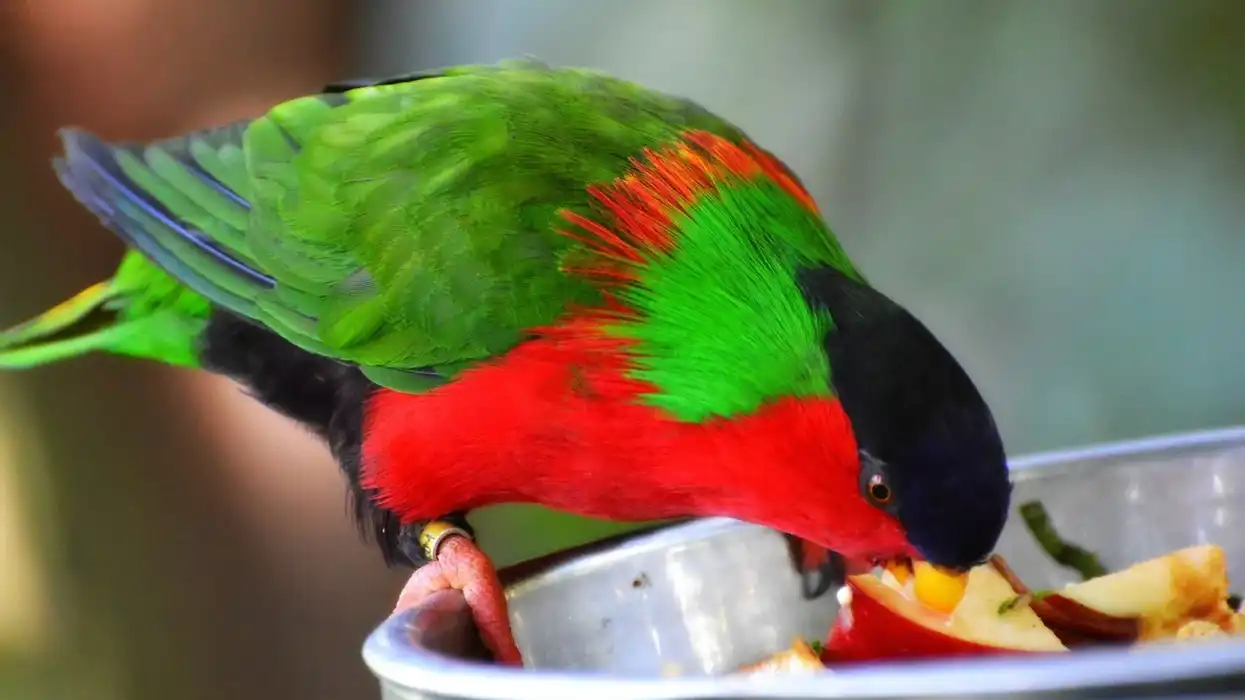The North American finch species, common redpoll (Acanthis flammea), is a tiny, energetic bird that is known to be one of the sturdiest to thrive in biting cold weather. The genus name, Acanthis, has its roots in the Greek language.
The word has been derived from the term 'akanthis' that stands for an 'unidentifiable small bird' while 'flammea' is from Latin meaning 'flame-colored'. Four separate subspecies have been identified namely the mealy redpoll (A. f. flammea), Greenland redpoll (A. f. rostrata), Icelandic redpoll (A. f. icelandica), and the lesser redpoll (A. f. cabaret).
Normally, these songbirds steer clear of human settlements as they populate remote, cooler habitats where their activities are unfettered.
Did you know that some of these birds remain under snow tunnels that protect them from the frosty winter climate by providing adequate insulation? They can withstand temperatures as low as -65 F (-53.9 C)!
These birds show erratic migration patterns. Some birds migrate far south while others don't even budge.
To learn more about the common redpoll keep reading. For more relatable content, check out these fox sparrow facts and lark sparrow facts for kids.
Common Redpoll Interesting Facts
What type of animal is a common redpoll?
The common redpoll (Acanthis flammea) is a species of North American birds of order Passeriformes, family Fringillidae.
What class of animal does a common redpoll belong to?
A member of the Acanthis genus, common redpolls have been grouped under the Aves class of finches.
How many common redpolls are there in the world?
A global population of 50,000,000-149,999,999 adult common redpolls has been estimated. The European population consists of 6,070,000-14,500,000 male and female pairs.
Despite the large population, a decline in the trajectory has been witnessed for the past 40 years within North America. This is primarily due to climate change, habitat loss, and degradation of the ecosystem.
The population of the species in Poland has been majorly affected owing to human activities such as recreational practices and conversion of land as a result of afforestation.
Where does a common redpoll live?
Common redpolls can be spotted throughout the central US and Eurasia. The winter range primarily includes the Arctic, southern Canada, and some states of the north as some flocks migrate far south. If you reside somewhere in Canada or Alaska, you might come across these birds in the winters when they visit feeders in search of food.
What is a common redpoll's habitat?
The habitat range of these North American birds encompasses shrublands, deciduous and conifer forests, urban gardens, willow flats, open plantations, and weedy fields. Small chattering flocks of these birds can be commonly spotted on small trees or in weedy fields foraging for seeds.
They can be occasionally traced in towns. Habitats also include Arctic tundra as well as boreal forests during the winter.
Who does the common redpoll live with?
Common redpolls are highly sociable birds. These finches flock together while foraging for food. Sometimes small flocks can also be spotted during the breeding season but migration in winter occurs in flocks of thousands. They also pair up during the breeding period.
How long does a common redpoll live?
In the wilderness, common redpolls can thrive for a maximum of seven to eight years. The longest living redpoll found in Alaska was aged seven years and eight months at least.
How do they reproduce?
Common redpolls breed in monogamous pairs. The breeding season generally commences in May and continues until July. The males perform ritualistic acrobatics to appease their female counterparts and often offer food during courtship.
The females construct cup-like nests in crevices of rocks, on low shrubs, tundra, or trees. Nesting materials include grasses, twigs, roots, and moss. Two to seven eggs are laid after which the females serve around 10-13 days of incubation. During this time, the males collect food and feed the females.
The nesting period extends for 9-16 days. The nestlings attain maturity within a year. These birds can raise three broods annually.
What is their conservation status?
Based on the observations of the International Union for Conservation of Nature (IUCN) Red List, the common redpoll (Acanthis flammea) has been incorporated in the Least Concern bracket due to its abundant population within its geographical range. However, climate change is one of the chief threatening factors that has significantly affected these birds through the last 40 years.
Common Redpoll Fun Facts
What does the common redpoll look like?
Common redpolls come in the combination of white-brown or gray-brown with heavy streaks on the sides. These tiny finches possess a rounded body structure, a forked tail, and white underparts.
The white wing bars and red patch on the forehead set them apart from chaffinches that have more brown. The wingspan of these birds measures 7.5-8.7 in (19-22 cm).
The beak is short and conical, fit for seed-feeding. During the breeding period, the males display a bright red hue on their breast, rump, cheeks, and crown while the yellow color of the beak changes to ochre.
Common redpolls display some regional differences because the birds residing in Greenland are darker in shade with a larger size when compared with the ones breeding in Canada or Alaska. Both the lesser redpoll and mealy redpoll are similar species that resemble the common redpolls in appearance..

How cute are they?
Common redpolls are one of the most exceptionally cute birds to inhabit the earth. They exhibit a soothing appearance with a white and brown-streaked body in dire winter conditions.
How do they communicate?
Common redpolls are the songbirds of North America that establish communication with their flock mates or other birds via innumerable sounds and calls. They're known to be busy chatterers while dwelling in flocks. Sharp, ascending 'dreeee' and buzzy 'zap' sounds have been identified with the species.
How big is a common redpoll?
The average length of common redpolls ranges from 4.7-5.5 in (12-14 cm). These birds are not too large and are quite similar to house finches measuring 5-6 in (12.7-15.2 cm) in length.
How fast can a common redpoll fly?
The flight speed of this finch species remains undeciphered due to the lack of detailed research data. However, these migratory birds can cover very long distances during the winter and are known to be extremely thrifty in their flight.
How much does a common redpoll weigh?
These seed-eating birds are pretty small in size and can weigh around 0.4-0.7 oz (11-20 g).
What are the male and female names of the species?
The males and females of this species have no distinct identifications and are therefore regarded as cocks and hens in general.
What would you call a baby common redpoll?
A baby of a common redpoll can be referred to as a chick, nestling, or hatchling.
What do they eat?
These birds are omnivores as they can be found feeding on a combination diet. Common redpolls eat invertebrates with soft bodies during the summer. Seeds of birch, spruce, willow, pine, and alder trees are the chief food sources.
These birds consume food (mostly seeds) that makes up about 42% of the total body mass every day. In winter, they visit seed feeders and feed on sunflower seeds too. Apart from the seed-enriched diet, they indulge in insects and spiders.
Are they dangerous?
These finches are pretty harmless when it comes to interactions with humans.
Would they make a good pet?
Common redpolls are not reared as pets so their behavior hasn't been ascertained. However, you can install bird feeders to attract these beautiful finches to your garden, especially in the winter season. Sometimes these birds visit these bird feeders in search of food when there's a scarcity.
Did you know...
Did you know that common redpolls have the unique ability of hanging upside down from branches of trees? This action is most visible while feeding as this enables them to gather and store seeds inside their expanded throat pouch for use in the future.
Since common redpolls are adapted to extremely cold climates, they do not possess traces of bare skin. The feathers that entirely cover up their body offer insulation to survive the freezing winter.
How to separate common redpoll from hoary redpoll?
Both common redpolls and hoary redpolls are members of the order Passeriformes, family Fringillidae, and class Aves. The former has a comparatively larger bill while the streaks on the chest are more pronounced than hoary redpolls.
What seeds does a common redpoll eat?
Common redpolls eat seeds mainly derived from pine, spruce, willow, birch, and alder trees. These seeds form a large percentage of the body mass every day.
Here at Kidadl, we have carefully created lots of interesting family-friendly animal facts for everyone to discover! Learn more about some other birds from our bald eagle interesting facts and pigeon fun facts pages.
You can even occupy yourself at home by coloring in one of our [free printable cardinal bird coloring pages].
Second image by D. Gordon E. Robertson









